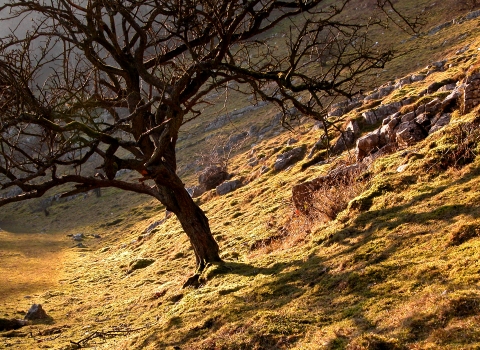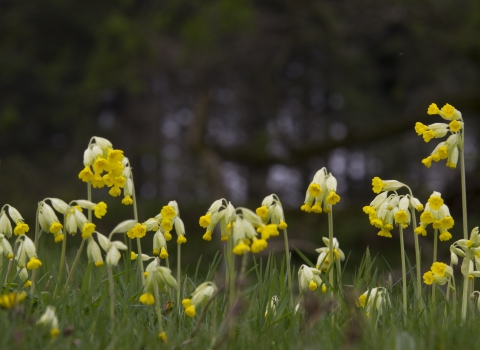
Ubley Warren - Matt Sweeting
Location
Know before you go
Dogs
Visit the 'Dog walking on reserves' page in the Contact section for more information.
When to visit
Opening times
Open at all timesBest time to visit
April to AugustAbout the reserve
Once an area of lead mining, this site contains uncommon habitats and vegetation communities that are in national decline. Nationally scarce plants recorded include the lead-tolerant dwarf mouse-ear and spring sandwort. Bat species, such as the lesser horseshoe bat, use the mineshafts.
There is much lead-rich soil here, a product of the lead mining which took place over hundreds of years. Few plants can tolerate lead in the soil but the nationally scarce Spring Sandwort and Dwarf Mouse-Ear can, and both can be found growing here. On the very thin soils directly over the limestone rock look out for Wild Thyme, Autumn Gentian and Early Purple, Bee and Frog Orchids. These limestone soils are also home to the nationally scarce Soft-leaved Sedge which is quite frequent, Hutchinsia and Brittle Bladder-Fern which grows in shady crevices on rock faces. In some areas where thick acidic soils have developed you will see Common Heather, Bilberry, Western Gorse, Tormentil and Heath Spotted Orchids.
Up to 30 species of butterfly have been recorded here including Dark Green Fritillary, Small Pearl-bordered Fritillary, Dingy Skipper, Grizzled Skipper, Green Hairstreak, Common Blue and Brown Argus. A good variety of birds use the reserve including some less common species such as Merlin which visit in winter, Stonechat which often sit on Gorse bushes, Redstart, Skylark, Tree Pipit and Wheatear. You will often spot Buzzards and Ravens circling high overhead. Come later in the year for the autumn colours of the Bracken, and the Hawthorn trees with their bright red berries attracting mixed flocks of tits and finches.
Several bat species use the mineshafts including Lesser Horseshoe Bats. Badgers and Foxes are resident in the reserve and Rabbits occur in large numbers. Roe deer are occasionally seen.
This is an excellent place to look for reptiles which love to bask on warm stony ground in summer. There is much bare rock here including “rakes” which are shallow gullies cut into the rock when following veins of best quality ore. Adders, Grass Snakes, Slow Worms and Common Lizards are all found here but you need to move very quietly to have a chance of seeing them.
As well as a favourite spot for reptiles, the rakes are also home to some rare plants that grow directly on the rock faces such as red tinted hawkweed.
Reserve conservation management - The reserve is managed primarily by grazing with cattle during the spring and summer, which keeps the vegetation low to allow flowering plants to flourish. Encroaching scrub is cleared to restore the grassland, although some smaller patches are being retained to provide cover for insects and birds. Invasive species are also being controlled to prevent them from dominating the grassland.
History and Archaeology - With its rakes cut into the limestone and deep mine shafts, Ubley Warren bears the scars of an industrial past. Lead was mined at Ubley Warren in pre-Roman times, continuing through to the 19th century and with the remains of rakes and bell-pits scattered across the site. This disturbed land is known locally as ‘gruffy’ ground, with lead still contaminating the soil in many places. Past industrial activity has helped to create the mosaic of vegetation types that are found on the reserve today.
Underground lies a hidden world of extensive passages and caves with spectacular rock formations, stalactites, stalagmites and flowstone, including the Upper Flood Swallet system.
Although these treasures remain beyond the reach of all but bats and very experienced cavers it is a fascinating world to imagine beneath your feet as you walk.
For more information and spectacular photos of these underground wonders visit www.mendipcavinggroup.org.uk
The legacy of centuries of opencast lead mining is evident in the uneven gruffy ground and worked-out mineral rakes at this site.
The limestone cliffs, rakes and exposures within the areas of mining disturbance are a dominant feature of the reserve, and support important communities of mosses, liverworts, lichens and ferns, some of which are rare.
A portion of a bowl barrow, also known as a tumulus, lies in south-east corner of reserve (SM reference: 1008287).



